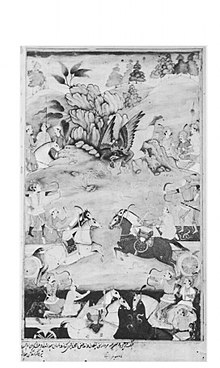| Sushama | |
|---|---|
| Information | |
| Weapon | Bow and Arrow |
| Family | Chirangada (uncle) |

Susharma (Sanskrit: सुशर्मा, romanized: Suśarmā) is the king of Trigarta in the Hindu epic Mahabharata. He was the brave Archer and a Competitor of Arjuna who vowed to either die or kill Arjuna as a part of a larger plan by Duryodhana to capture Yudhishthira alive in Kurukshetra war. For this, he used the Samsaptak Shakti against Arjuna Nagastra in 8th day on the battle of Kurukshetra and also formed a suicide squad on 11th night of the war. On the 13th day of the battle, he kept Arjuna distracted from the Chakravyuh, even though he knew that he could not defeat Arjuna. He was assigned this task because the Kaurava commander Dronacharya had created the Chakravyuh to capture Yudhishthira and no one in the Pandava army knew how to break the Chakravyuh except Arjuna. Fearless Susharma was killed along with his brothers by Arjuna in the battle of the same day.
Legend

During the Kurukshetra War, Susharma attacked Virata, the king of the Matsya Kingdom, but was defeated by Bhima. Just like Arjun bow "GANDHIV" He also as a Bow which was called " RAKTABEEJ " by him for the destruction happen on Mahabharata and Virata Yudh .Susharma was responsible for distracting Arjuna on the thirteenth day of the war. On the thirteenth day, Drona instructed the Kaurava forces to organise in a chakravyuha formation to kill Yudhishthira. Aware that Arjuna and Krishna knew how to break the formation, Susharma distracted them, ensuring that they would be on the other side of the chakravyuha. He was killed by Arjuna on the final day of the war while the rest of his army was retreating.
References
- Chakravarti, Bishnupada (13 November 2007). Penguin Companion to the Mahabharata. Penguin UK. p. 46. ISBN 978-93-5214-170-8.
- "Brief biographies of some main characters in the Mahâbhârata and Bhâgavata Purâna (S'rîmadBhâgavatam)". Vahini.org. VAHINI. Retrieved 17 July 2016.
- "The Mahabharat, Book 8: Karna Parva: Section 53". www.sacred-texts.com. Retrieved 9 June 2020.
This Hindu mythology–related article is a stub. You can help Misplaced Pages by expanding it. |